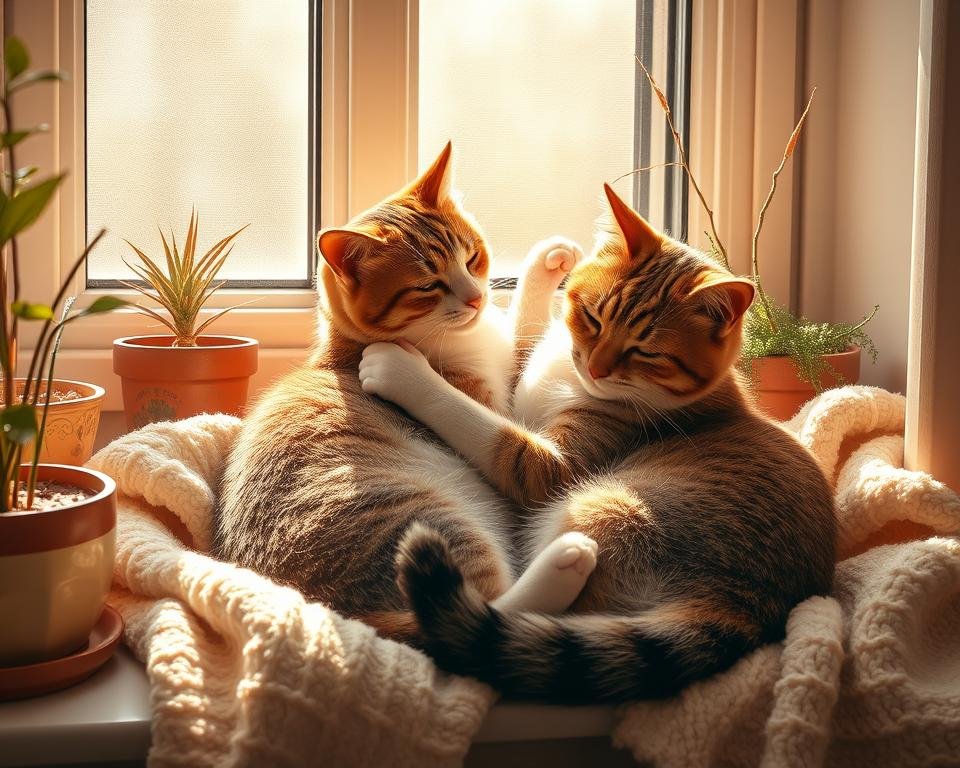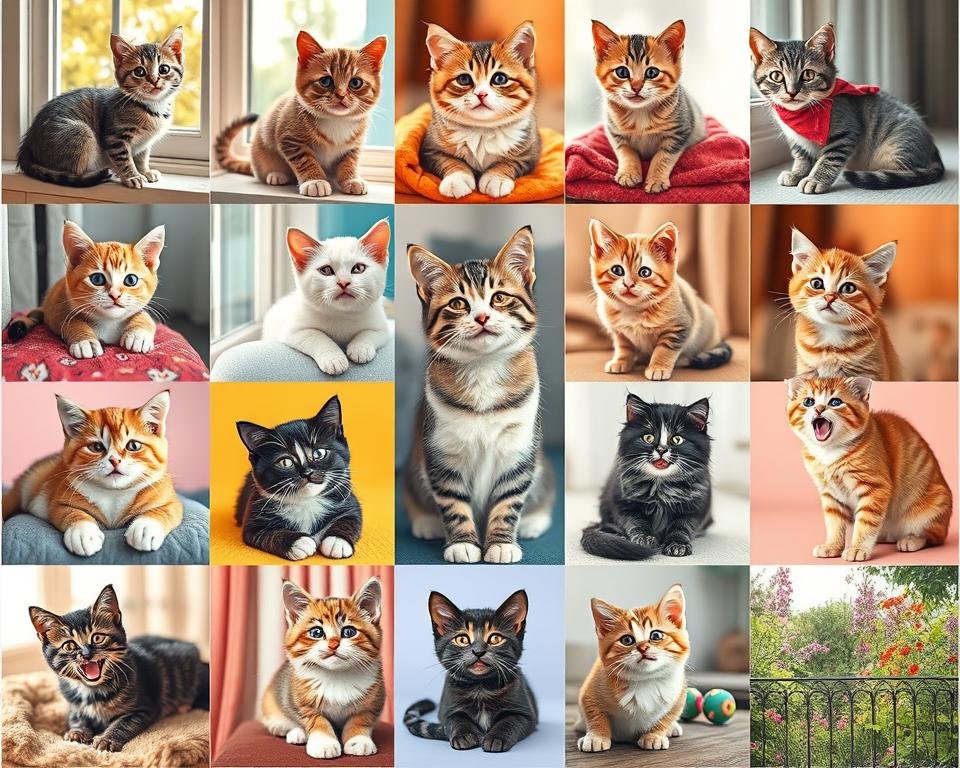Cats do feel a wide range of emotions, from fear and happiness to love. Recent studies have shown that cats are more emotional than we thought. They are not just aloof. By understanding cat emotions, we can connect better with them and care for them more.
Cats show emotions like surprise, fear, and happiness, just like a 2 ½-year-old child. They use sounds, facial expressions, and body language to share their feelings. They also seek comfort and affection when they’re upset or scared.
The Science Behind Cat Emotions
Cats feel many emotions, like fear, happiness, and sadness. They don’t show emotions like humans do because they used to live alone. But, studies show cats can understand and feel emotions from their owners and others.
Basic Emotions in Cats
Cats can feel many emotions, but not as complex as humans. They have basic emotions that help them act and interact with people. These emotions are key to their behavior around humans.
Evolution of Emotional Capacity
Cats’ emotions come from their wild past. They didn’t need to show emotions like social animals do. But, they can understand human emotions and react to them.
Research and Scientific Evidence
Many studies have looked into cat emotions. One found that playing with cats can make people feel better. Cats also form strong bonds with people and can sense their emotions.
As we learn more about cat emotions, we’ll understand them better. This will help us take better care of our feline friends. You can learn more about cat emotions and their needs.
“Cats are capable of experiencing a wide range of emotions, though more complex emotions like guilt, embarrassment, and jealousy are unlikely.”
Understanding Your Cat’s Emotional Range
Cats are complex creatures, feeling a wide range of emotions. They can feel fear, anxiety, happiness, and relief. Understanding your cat’s emotional range is key to caring for them.
Cats can feel emotions like fear, anxiety, happiness, relief, frustration, and depression. They don’t show these feelings as openly as dogs or humans. But, they communicate through body language, sounds, and actions. Knowing these signs helps you understand how they feel.
Cats might not understand why they’re in pain, like with a urinary tract infection. But, research shows they can form strong bonds with their owners. They might even love them.
“Cats have surpassed dogs as the most popular pet in many countries, and there is a growing focus on their emotional wellbeing, in addition to physical and mental needs.”
While cats don’t show complex emotions like guilt or jealousy, they do feel basic emotions. Knowing how your cat feels helps you care for them better. It also strengthens your bond with them.
- Cats can experience a variety of emotions, including fear, anxiety, happiness, relief, frustration, and depression.
- They communicate their feelings through subtle body language cues, vocalizations, and behaviors.
- Cats may form emotional attachments with their owners, potentially including the capacity to love.
- Recognizing your cat’s emotional state can help you provide the best possible care and create a strong, loving bond.
Signs of Cat Emotions Through Body Language
Cats show their feelings through body language. By knowing these signs, we can understand what our pets are feeling. This helps us respond in the best way.
Tail Positions and Meanings
A cat’s tail tells a lot about their mood. A tail held high and slightly curved means they’re happy and confident. But, a tail that’s low or tucked in might show fear or anxiety. If the tail is twitching or thrashing, the cat might be feeling irritated or angry.
Facial Expressions
Cats use their faces to show their emotions. Happy cats have round or half-closed eyes and narrow pupils. Wide eyes and big pupils can mean they’re playful or stressed, depending on the situation.
Ear Movements and Positions
A cat’s ears tell us a lot about their feelings. When their ears are relaxed and forward, they’re usually happy. But, if their ears are flat against their head, they might be scared or upset.
“Facial expressions such as ears rotations and eye movements can indicate a cat’s emotional state, signaling irritation, fear, contentment, or aggression.”
It’s key for cat owners to understand these signs. By watching cat emotions through body language, we can strengthen our bond. We can also give our cats the care they need for a happy relationship.
How Cats Express Love and Affection
Cats show love and affection in their own special way. They don’t express feelings like humans or dogs do. But, they have behaviors that show they care deeply for their owners.
One key sign of a cat’s love is the slow blink. When they look at you and blink slowly, it means they trust and feel happy. Humans can blink slowly back to show love too.
- Head butting, or bunting, shows a cat’s love. They rub their heads against you to mark their territory and show they’re attached.
- Kneading is a sign of safety and comfort. It reminds us of when kittens knead their mother’s belly for milk. Adult cats do it when they feel safe and content.
- Cats may chirp to show they’re happy and want attention. This soft sound is a sign of joy and affection.
Cats may not show love as openly as other pets. But, their actions show a strong bond with their humans. By understanding these signs, cat owners can see how much their pets care for them.

“Cats have a way of living that is both inscrutable and touchingly vulnerable.” – Jodi Picoult
Cat Emotions: From Fear to Happiness
Cats are complex creatures, feeling a wide range of emotions. They go from fear and anxiety to joy and contentment. Knowing these emotions helps us better care for our cats and strengthen our bond with them.
Signs of Fear and Anxiety
When cats are scared or anxious, their body language is clear. Look for dilated pupils, flattened ears, and a tucked-in tail. They might hide more, startle easily, or show defensive signs like hissing or growling.
Indicators of Happiness and Contentment
Cats show happiness and contentment in different ways. They might have a relaxed posture, upright ears, and a swishing tail. Purring and slow blinking also mean they’re feeling secure and happy.
Understanding Frustration and Relief
Cats can feel frustrated and relieved too. If they’re focused on something or pacing, they might be frustrated. But, a full-body stretch or returning to calm after stress shows they’re relieved.
By recognizing these emotional cues, we can better meet our cat’s needs. This helps us build a stronger, more loving relationship with them. Understanding cat emotions is key to connecting with our feline friends.
“Cats can form bonds with their human companions and understand human emotions through tone, facial expressions, and body language.”
Do Cats Understand Human Emotions?
Many studies show that cats can recognize and respond to human emotions. They can read our facial expressions, tone of voice, and body language. This helps them understand how we feel.
When we smile, cats may want to play or get closer. They don’t feel emotions as deeply as dogs do. But they can sense when we’re upset or happy and may try to comfort us.
A study in Italy showed cats can tell when we’re happy or angry. Another study in 2015 found cats react to our smiles and frowns. They can even tell when we’re happy or angry by our sounds.
Cats have many ways to show their feelings, like tail movements and eye contact. They can look relaxed, scared, or even aggressive. Their bond with us makes them very sensitive to our emotions.
Changes in a cat’s life can affect their mood. This is often because of how we feel. Cats in cities with people and other cats are more sensitive to emotions than those in quieter places.
In short, research shows that cats can sense depression and anxiety in humans. They can tell their owner’s emotions through different signs. This makes their bond with us even stronger.
Common Misconceptions About Feline Feelings
Many people think cats feel emotions like humans do because they like to see animals as people. But cats don’t feel the same complex feelings as us, like guilt or embarrassment. This way of thinking can make us misunderstand our cats and react in the wrong way.
Anthropomorphism and Its Effects
Cats feel and show emotions in their own way, not like humans. When we think our cats feel like us, we might get their behavior wrong. For instance, if a cat doesn’t use the litter box, it’s not because they’re mad. It’s probably because they’re sick or uncomfortable.
The Truth About Complex Emotions
Some people think cats are less loving than dogs because they don’t show emotions as much. But studies show cats can really bond with their owners and even mirror their actions. Cats do feel basic emotions like fear, joy, and happiness. Knowing this can help us take better care of our cats.
can cats sense depression and anxiety in humans
Several studies indicate that cats can tell your emotions through a combination of vocalizations, body language, and scent. They are highly attuned to the behavioral changes we exhibit when feeling down or anxious, often reacting to shifts in our energy levels and mood. For instance, when a person appears sad or withdrawn, a cat might sidle up close, offering their presence as a form of silent support. This instinctive behavior showcases their inherent sensitivity, further blurring the lines between animal and emotional intelligence.
Additionally, do cats feel emotion? While their emotional expression may not be as overt as that of dogs, research suggests that cats experience a range of feelings, including affection, happiness, and, yes, even empathy. Their capacity to form close bonds with humans allows them to engage in a unique emotional exchange, which may provide comfort during tough times. This bond can manifest as purring when they’re near a distressed owner or playful behavior meant to redirect the owner’s focus, highlighting their potential role as informal therapists.



